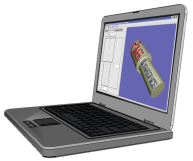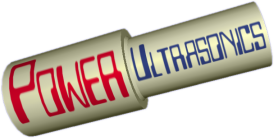A new online ultrasonics components store has just opened at www.UltrasonicsWorld.com. Check their amazing prices for replacement ultrasonics components, fully compatible with the major manufacturers' originals at a fraction of the cost.
You are here
About PowerUltrasonics and the author
PowerUltrasonics.com was created by me, Chris Cheers. For anyone interested, this is the story...
 After growing up in Manchester and the mountains of North Wales, I studied Engineering at St. John's College, Cambridge, graduating in 1984. On joining the Research and Development division of Metal Box plc (now swallowed up by the US packaging giant Crown Cork and Seal) at Wantage, UK, my first position was working for Paul Porucznik - a brilliant (if a bit eccentric!) engineer. Paul had proposed using ultrasonics in a new metal-forming process for manufacturing aerosol cans. I began evaluating the benefits of using high-power ultrasonics but quickly found that these were barely measurable and there was practically no chance of the process working! So began a long research project to develop new, high efficiency ultrasonic equipment to make the idea work.
After growing up in Manchester and the mountains of North Wales, I studied Engineering at St. John's College, Cambridge, graduating in 1984. On joining the Research and Development division of Metal Box plc (now swallowed up by the US packaging giant Crown Cork and Seal) at Wantage, UK, my first position was working for Paul Porucznik - a brilliant (if a bit eccentric!) engineer. Paul had proposed using ultrasonics in a new metal-forming process for manufacturing aerosol cans. I began evaluating the benefits of using high-power ultrasonics but quickly found that these were barely measurable and there was practically no chance of the process working! So began a long research project to develop new, high efficiency ultrasonic equipment to make the idea work.
The first change was the transducer: Metal-forming applications had traditionally used magneto-strictive transducers to generate the ultrasonic vibrations. These use coils of wire around a laminated core, like an electrical transformer - they are robust but very inefficient. Using piezo-electric transducers borrowed from the plastic-welding industry, the vibration amplitude under load was increased by about 300%! Using titanium or aluminium alloys for the bulk of the die further improved the efficiency of the system so that while not under load the power drawn was less than 100W.
The improved efficiency highlighted existing problems with the ultrasonic dies - the desired mode of vibration was a uniform radial expansion and contraction of the die, but the reality was often very different. Several unwanted modes of vibration were identified and the die design was improved to eliminate them.
A further problem concerned the mounting of the ultrasonic equipment. If mounted on the booster flange, as is normal for plastic-welding systems, the die would deflect under the force of the metal-forming process, causing misalignment to the rest of the tooling. A new mounting system was designed, fitting directly to the back surface of the die. This provided rigid support against the forming forces but, thanks to its design, still permitted the die to vibrate with hardly any resistance.
Two patents covering these developments were filed in 1988 and 1990, in the names of Chris Cheers and Paul Porucznik.
The final development of the new ultrasonic system was done as a collaborative research project with Loughborough University, sponsored by the Science and Engineering Research Council. Researchers Margaret Lucas and Mike Shellabear developed new methods of evaluating and analysing the vibrations, while I continued to optimise the designs using finite element analysis. All three of us were eventually awarded PhDs on completion of our research. Thanks are due to supervisors Dr. John Tyrer (electronic speckle pattern interferometry) and Prof. Graham Chapman, now at De Montford University (modal and finite-element analysis).
The ultrasonic forming process finally went into production making small-diameter aerosol cans in a UK factory. One of its products ("Fleurs de Paris" parfum deospray can) won a silver in the 1997 Metal Packaging Manufacturers Association awards.
Other projects undertaken during and after the ultrasonic forming work included new machinery for manufacturing cans and ends, for applying caps to glass jars and improving the heat-processing of canned foods. A further six patents were filed for these developments, on which I was named as inventor along with various colleagues. My last role with Crown Cork was as team-leader of the Can-shaping team, creating the new manufacturing processes and machines needed to produce these special customised cans for customers such as Heineken and Coca Cola.
I left Crown Cork at the end of 1998 to pursue a new life in Australia as an independent consultant. Since the industrial use of ultrasonics in Australia is limited I now divide my time between ultrasonics consultancy for international clients and web design / internet programming work for mostly local clients. The PowerUltrasonics.com site was my first example of semi-commercial web design, created in 1999 with a back-end update and added content in August 2004. The current site was created using Drupal content management framework in early 2008, giving it a fresh new look (much needed!) and providing a combined login for the many different sections of the site.
On a more personal note, I met Fiona, an Australian and a "real doctor", in early 2002 and we were married at the end of 2003. We now live in a still-not-quite-finished house overlooking Lake Macquarie, about 1 hour north of Sydney, Australia.

